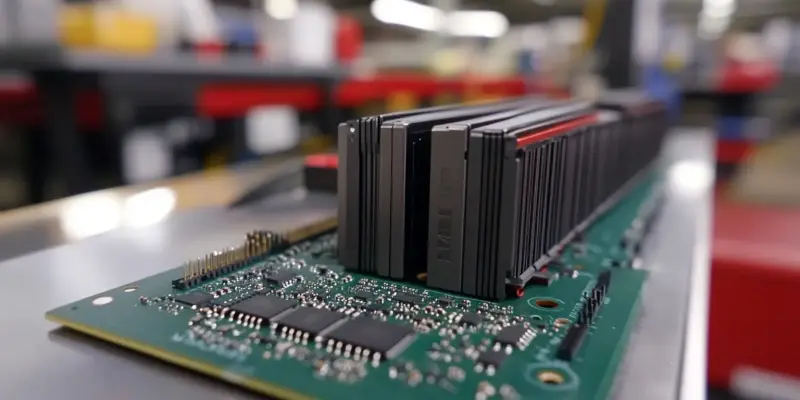The high-end CPU market is currently witnessing fierce competition between AMD and Intel, with AMD gaining significant ground. The recent conflict and challenges surrounding AMD’s Ryzen 9800X3D and Intel’s Arrow Lake CPUs have led to notable industry movements and consumer reactions. This article delves into the dynamics of this competition, highlighting AMD’s rise and Intel’s struggles.
AMD’s Ryzen 9800X3D: A Game Changer
AMD’s high-ranking executives, particularly Frank Azor and David McAfee, have emphasized the unexpectedly high demand for their Ryzen 9800X3D processor. This demand is partly attributed to the perceived shortcomings of Intel’s latest Arrow Lake CPUs. Since its launch, the Ryzen 9800X3D has been highly regarded as the best gaming CPU available, receiving stellar reviews and strong consumer demand. This popularity has led to stock shortages and inventory issues for AMD. The strong consumer demand is a testament to the product’s excellent performance, positioning the Ryzen 9800X3D as a standout in the competitive landscape.
At the CES 2025 roundtable, Frank Azor candidly criticized Intel’s Arrow Lake performance, calling their latest CPUs “horrible.” This sharp criticism from AMD’s consumer and gaming marketing head underscores the competitive nature between the two tech giants. The high demand for Ryzen 9800X3D has far exceeded AMD’s prior estimates, leading to production and forecast challenges. Azor’s comments not only reflect AMD’s confidence in their products but also highlight the pressure Intel is under to deliver. As AMD capitalizes on the success of the Ryzen 9800X3D, the CPU landscape continues to shift in the company’s favor.
Production Challenges and Consumer Demand
David McAfee provided insights into the production challenges AMD faces. The high demand for Ryzen 7 9800X3D and the 7800X3D was unprecedented, far exceeding their prior estimates. The manufacturing process for these high-performance CPUs, including the 3D V-Cache stacking technology, introduces additional complexity and time, making it difficult to quickly ramp up production to meet the unexpected surge in demand. This indicates that while AMD’s technology is ahead, keeping up with production to satisfy consumer demand is an evolving challenge.
McAfee emphasized that AMD has significantly increased its outputs and plans to continue doing so into the first half of the year. However, it suggests that until mid-2025, the 9800X3D might remain challenging to procure. Despite these challenges, AMD is committed to addressing supply issues and meeting consumer demand. Steps to ramp up production underline AMD’s dedication to maintain its market lead. The company recognizes the importance of meeting consumer demand promptly to capitalize on the current market momentum.
Consumer Preferences and Market Trends
McAfee highlighted the demand variance between Ryzen 7 and Ryzen 9 X3D processors. The more affordable 8-core models outsell the 9-core variants by a substantial margin of 10-to-1. This indicates that the Ryzen 7 X3D series hits the sweet spot in terms of performance and price for gamers, making it the preferred choice over higher-tier models with marginal gaming performance improvements. The affordability and performance balance offered by the Ryzen 7 lineup make it a popular choice among consumers, emphasizing the importance of pricing strategy in the high-end CPU market.
The introduction of new Ryzen models like the 9950X3D and 9900X3D at CES 2025 will not alleviate the high demand pressure on the 9800X3D, as consumer interest predominantly remains fixed on the Ryzen 7 lineup. This trend highlights the importance of balancing performance and affordability in the high-end CPU market. As AMD continues to innovate, understanding consumer preferences will remain crucial to maintaining its competitive edge. Moving forward, the strategic focus will likely be on strengthening the most popular product lines while exploring opportunities for incremental improvements.
Intel’s Struggles with Arrow Lake
Turning to Intel, the discourse shifts to their struggles with the Arrow Lake CPUs, which launched in October 2024. The Arrow Lake debut was marred with issues, particularly failing to meet gaming performance expectations that Intel had set. This further compounds Intel’s woes following significant instability issues with their previous 13th and 14th Gen Core CPUs, which took a damaging toll on their reputation throughout 2024. The series of setbacks faced by Intel has challenged the company’s standing in the competitive CPU market, intensifying the need for substantial recovery efforts.
Though Intel has implemented several fixes for Arrow Lake, including an outstanding final measure yet to be deployed, the improvements remain insufficient according to limited testing reported by Tom’s Hardware. This ongoing struggle underpins AMD’s aggressive stance in critiquing Intel’s latest offerings and signaling confidence in their own products. The ongoing issues faced by Intel highlight the broader implications of product performance and reliability in maintaining consumer trust and market share.
Market Dynamics and Strategic Implications
The high-end CPU market is experiencing intense competition, primarily between AMD and Intel. AMD has been making impressive gains, challenging Intel’s long-held dominance. The ongoing conflict and hurdles involving AMD’s Ryzen 9800X3D and Intel’s Arrow Lake CPUs have sparked significant industry moves and notable consumer reactions. This fierce rivalry is reshaping the market landscape, with AMD demonstrating substantial improvements and innovations in its processors. On the other hand, Intel has been facing some struggles, striving to maintain its leadership while adapting to the rapidly evolving technologies and consumer expectations. This competition is not just about technological advancements but also about market share and brand loyalty. As AMD continues to rise, offering competitive pricing and high performance, Intel is compelled to step up its game, pushing both companies to innovate further. Consumers ultimately benefit from this battle, getting access to better technology that keeps advancing at a fast pace. The article delves deeply into these dynamics, examining how AMD’s rise and Intel’s efforts to stay relevant are shaping the future of the high-end CPU market.

